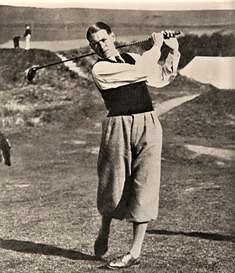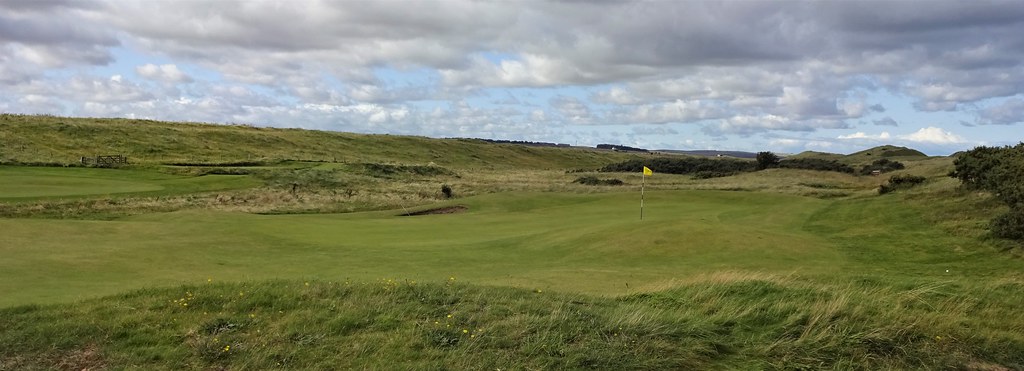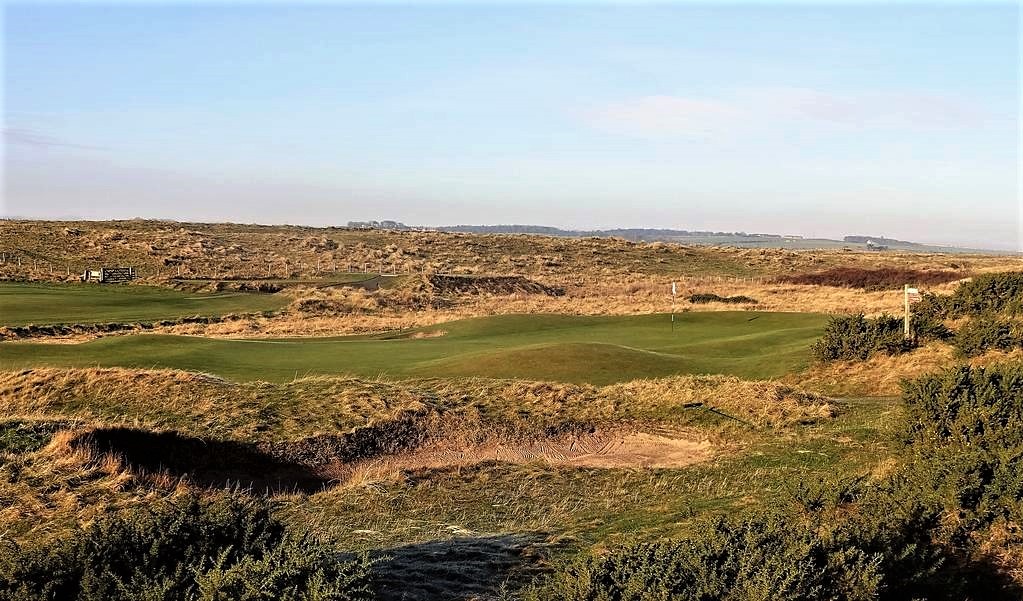The links at Goswick lie just south of Berwick upon Tweed. The Scottish border is a mere few miles to the north. One can guess that Berwick upon Tweed changed hands on many occasions during the four hundred years of border wars between Scotland and England. 1482 was the last time England took possession of the town and this remains the case to this day. When the Act of Union between England and Scotland was put into place in 1707 it effectively ended the dispute. Though, there will always be cranks in any neighbourhood as Christine Grahame MSP clearly demonstrates.
The club is approached by a serpentine road off the A1. There is no sign a course is in the neighbourhood until the clubhouse and links suddenly appear after rounding a sharpish bend. The hamlet of Goswick consists of maybe 15 dwellings and is hard on Goswick Sands which connects with The Holy Island of Lindesfarne (usually shortened to Holy Island) via the Holy Island Causeway. For a population of approximately 200 persons the island does have its share of landmarks which help create an air of expectation when visiting...and visiting is well worth while.
The evolution of Goswick is not materially different from that of dozens of links. Many an architect has had a turn at Goswick, the names include the original designer, T Dunn, who in 1889 chose the land and designed holes extending to the present 12-14. Not five years later a cadre of members with the help of one R Collins were responsible for extending the course northward to create 18 holes. In the following ten years both Willie Fernie and Willie Park made their mark. The advent of the Haskell pushed the club to engage James Braid in 1930 to perform extensive work to the links; as many as 13 holes were altered in one way or another. In 1963 the unheralded Frank Pennink was called in to have his say concerning the front nine. The club greenkeeper, George Thompson continued improving the course from 1966 to finally arrive at the 6800 yard beauty which exists at present. Despite the many hands involved at Goswick, the links feels like a united design and for that we can thank the intelligent use of the terrain and the outstanding quality of the turf. George Thompson is due more than a passing mention for not succumbing to the water and feed craze of the 80s and 90s. The sense of cohesion is also due to the links being evenly divided by the house; nine holes to the north and nine to the south. The quality of the often sporting terrain too is evenly split which results in each half having about the same number of the best holes.
I feel compelled to devote a few paragraphs to Frank Pennink before moving on. Rather like Donald Steel, Pennink was a man of many talents where golf is concerned. He earned a blue at Oxford while playing for the side between 1933 and 1935; captaining the team in his final year. After taking up a position with an insurance company (sound familiar?) Frank won the English Amateur in 1937 and 1938. Because of these wins and others he was selected for the 1938 Walker Cup Matches held at St Andrews; incidentally a team which beat the Americans for the first time. As was the case with many sportsmen, WWII robbed Pennink of prime competitive years. Spending the war years as an RAF Squadron Leader, it is doubtful there was much time to dream about what could have been on the links.
Turning to journalism after the war, Frank covered golf for the Daily Mail and Sunday Express. His writing led to the development of a unique voice about courses which resulted in the publication of Homes of Sport: Golf in 1952 and The Golfer’s Companion in 1962. It was clear that his keen eye for the places of golf would be of great benefit in the design aspect of the game and thus Frank joined the architectural firm of Ken Cotton and Charles Lawrie where he worked on many courses throughout the UK and Europe. It shouldn’t be forgotten that Pennink also served the game through his work with the English Golf Union, of which he was president in 1967 and Walker Cup selector.

The competition scorecard. Yardages, what yardages? Notice Local Rule 3! The card is also perforated to remove the marker's score.

For all the wonderful aspects of links golf which Goswick gives us, the first is an odd duck. First off, it plays to the east. With internal OOB hard right, a fairway working around a copse and a green which is set at an awkward angle, perfection is not the word which comes to mind when describing the hole. For all that, this hole, like the other 17, belong to the Goswick genealogy so it can't be bad. Looking toward the tee.

Nobody could question the fantastic variety of terrain and conception of Goswick's short holes. A medium length par three, the second plays over a deep hollow to a somewhat large green.

I think this is what the hole looked like in 1903 after Willie Park Jr made some changes. It was then the 10th, following the what is currently the 17th. The tee would have been just above the current ladies 18th tee, making for a much more adventurous hole than exists today.

Looking toward the tee.

The tee shots for three and four are a similar challenge being leggers to the right. #3

The movement from the right surrounding the bunker is superb.

The 4th plays somewhat similar to the third in that the hole tumbles down from the dunes. The green is a very severe target to receive long iron/wood play. In the winter of 2023-24 the green was made a bit wider as it was thought there weren't enough hole locations. Below is the previous green.


One gains a better look at the tight green from near the 5th tee.

More to follow.
Ciao